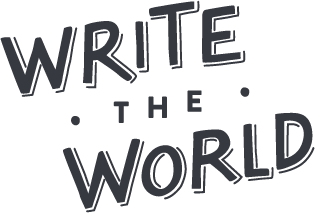In entering our Letter Writing Competition, Hannah Flores (Canada) was stepping outside of her usual spoken word genre. But it was her experience as a spoken word artist that contributed to her powerful and artful letter “To the Only Black Person in the Room.” Guest Judge Brother Richard Hendrick praised Hannah’s entry for, among other things, its rhythm, cadence, and precision. “I often read sentences or paragraphs aloud in order to ensure that it sounds correct to express verbally,” Hannah says. “That is how I gauge whether a report, sentence, or even individual word has earned its position in the piece of writing or not.” Great advice for any writer, whether their work is meant to be spoken or read!
We talk to Hannah about her process and the cathartic experience of writing this letter, which books she recommends to her fellow writers, and more.

How did you decide who to write your letter to?
I decided to address my letter to the only Black person in the room because I have been that person on numerous occasions. As a high school student currently taking advanced level courses and striving for post-secondary education at top universities in Canada, I have noticed a lack of representation in these new classrooms. I must continue my observations as I move forward in my education, as the number of faces I see who look like me will continue to dwindle. I am constantly outrunning the walls that attempt to close in on me, and I must reject the intense claustrophobia that they promote. I have also grown up in neighborhoods where the Black population remains a minority. It can be very lonely, embracing such a racially-charged solitude in a space that you are often not encouraged to be in. However, I wanted readers who experience similar situations or who currently live through this to realize that while it can be lonely at times, they are not alone. As Brother Richard Hendrick said, this was also a letter to myself, as I now see that my letter concludes with a mantra that I should repeat to myself whenever I do find myself in extreme vulnerability in order to stay grounded.
I was also motivated by the current global movement for positive change to illuminate an emotionally intense issue that is often cast from conversations in both Black and non-Black demographics. “Being the only Black person in the room” can occur at any given moment, thus catching one off guard. It is important that members of the Black community filter out the voices and nuances present that aim to push them out of a space, club, organization, or environment. Black perspectives and contributions have been gated out of the loop for centuries and a call to action is long overdue. I need to practice being comfortable in my own skin and bringing my own seat to the table when necessary.
Guest judge Brother Richard Hendrick said, “This is a piece that deserves to be read out loud to the widest audience, its rhythms and cadence have a percussive feel, there is a military drum playing behind the voice of the writer with each word and image laid down as precisely as a surgeon lays out their instruments of healing.” Obviously, your spoken-word background came through! Did you write this piece with an idea of performing it, or is rhythm a natural part of your writing voice due to your spoken-word experience?
In fact, I did not write this letter intending to perform it at all! The competition caught my eye because I wanted to write in a style that is outside of my typically poetic regimen. Letters, for me, are often written for professional or academic purposes. I took this opportunity and ran with its freedom of creativity. It was not until after I had read through my final draft that I realized its subtle musicality. I often read sentences or paragraphs aloud in order to ensure that it sounds correct to express verbally. That is how I gauge whether a report, sentence, or even individual word has earned its position in the piece of writing or not. Spoken word poetry is a form or storytelling, and this transcends into my work because there is nothing worse than a story that is not engaging to read. I aim for my writing to be enjoyable to share and experience in order for my messages to touch my audience. Writing can feel like decorating a Christmas tree at times, with each phrase having intention, significance and beauty in its place amongst the others that complete the piece.
Brother Richard Hendrick also noted that your piece reminded him that “a letter has the power to move hearts, heal souls and challenge society.” You identify as primarily a poet; how did the process of writing a letter compare to your process of writing a poem?
With writing my letter, I truly intended it to be as personal as possible and for the words to form a capsule of custom assistance and comfort for whom it is addressed to. When I write poetry, I usually imagine a more diverse audience and tailor my writing slightly in order for people from all walks of life to take something away from it. In the process of performing and building my poetry I, first and foremost, write for myself and write from personal experience. It just so happens that I have a complex personal experience with the subject of my letter, allowing for the words to flow seamlessly onto the page. However, instinctively with “To the Only Black Person in the Room,” I was writing to a specific person. I could see this person, hear their voice, and feel their pain. I went through a list of various questions such as “What does this person need to hear?,” “If this was the only letter that I could send to this person, was everything that needed to be said included in these paragraphs?” and “If I received this letter in the mail, would it have given me joy and direction?” This was such an incredible project to carve out and it definitely allowed me to engage in some major introspection. Writing “To the Only Black Person in the Room” was like a calming exhale, and I only realized how much it allowed me to breathe once it was completed.
What book(s) have you read recently that you would recommend to other young writers?
I have recently read The Marrow Thieves by Cherie Dimaline, A Tree Grows in Brooklyn by Betty Smith, and Washington Black by Esi Edugyan. This is an eclectic collection of diverse authors and writing styles that convey important messages that will remain relevant for generations. They are all exciting, bold, and invigorating reads that make you feel as if you are no longer reading, but watching a film unfold, so I would highly recommend them. Not only that, The Marrow Thieves and Washington Black are by incredible Black and Indigenous authors.





